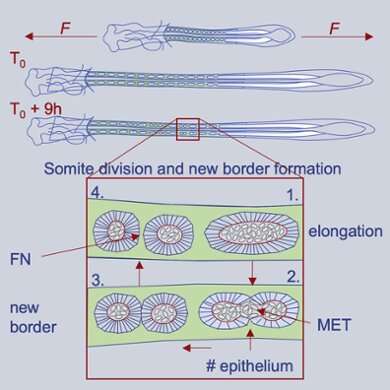Mathematical model helps to explain the formation of spine and ribs

At an early stage in vertebrates' embryonic development somites form: these are primitive segments from which the spine, ribs, back muscles, cartilage, tendons and part of the skin develop. It is known that mechanical forces play a role in the development of those somites, but in which way was still unknown. Professor of Mathematical Biology Roeland Merks and researchers at the Amsterdam UMC have now found an explanation. They published their findings in iScience, an interdisciplinary open-access journal of Cell Press.
Pushed out
Merks collaborated with Professor of Translational Regenerative Medicine Theo Smit and his team from the Amsterdam UMC. The researchers used a new, experimental technique on somites from chicken eggs 24 hours after fertilization. At that time, somites are forming, but organs like the heart are not yet developed. To investigate the role of mechanical forces the researchers exposed the somites to extra stretching. While somite formation continued as usual, already formed somites split into two or more parts.
Merks' mathematical model explained this. Merks says, "A somite is a kind of vesicle with sturdy epithelial cells on the outside and so-called mesenchymal cells in the core, which are more motile. Our mathematical model suggested that by stretching a somite, the motile mesenchymal cells in the nucleus are pushed into the layer of sturdy epithelial cells. Then the cells are taken up in that outer layer and there is a separation in the somite. This creates two somites."
Reversed process in metastasis
The Amsterdam UMC examined whether the mathematical model is correct. The team counted the number of mesenchymal cells and epithelial cells before and after stretching. The researchers were able to deduce that through stretching, motile mesenchymal cells from the nucleus of the somite were indeed absorbed into the sturdy epithelial tissue on the outside, exactly as the model predicted.
The same process also occurs the other way around, with cells that separate from an epithelial tissue. That process is a key step in cancer metastasis. Other studies in which Merks and co-authors are not involved have recently shown that mechanical forces also play a role in this. In addition to more insight into embryonic development and the role of mechanical stretch, the study may provide leads for further research into the role of mechanical stretch in cancer metastasis.
More information: Ben K.A. Nelemans et al. Somite division and new boundary formation by mechanical strain, iScience (2020). DOI: 10.1016/j.isci.2020.100976
Journal information: iScience
Provided by Leiden University



















